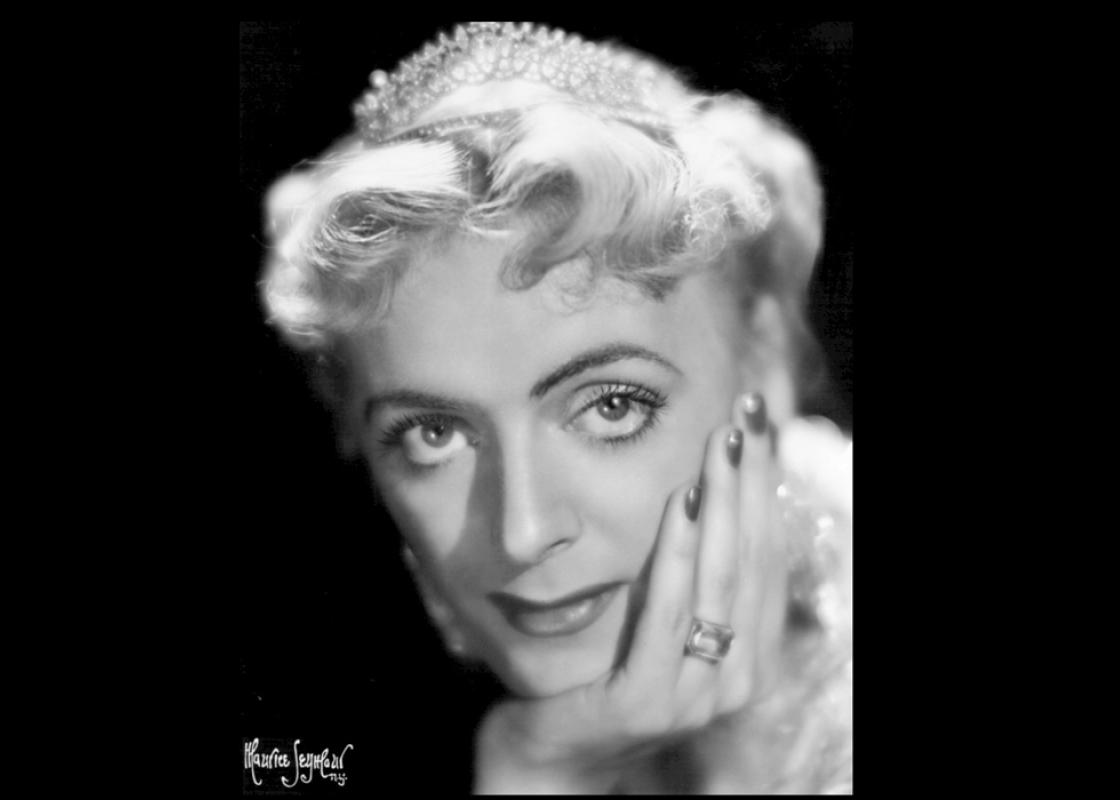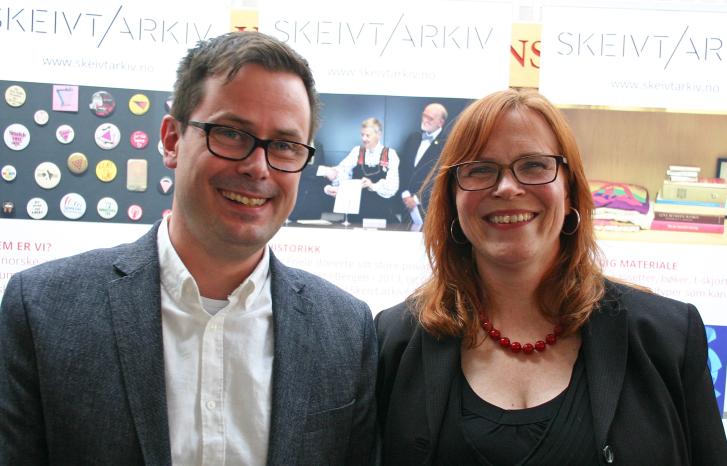‘From ex-soldier to blond beauty’. These words covered the front page of Daily News 1 December 1952. The news story was about Christine Jørgensen, previously George, who had undergone gender-confirming treatment in Copenhagen. It was the story about the world’s first successful gender reassignment treatment, a story that would also be significant in Norway.
“In the 1950s, medical doctors began to experiment with gender hormones, and at the same time, people started to think differently about gender in society,” says Sigrid Sandal.
She is an historian, and has recently submitted her master’s thesis En særlig trang til å ville forandre sitt kjønn. Kjønnsskiftebehandling i Norge 1952-1982 (‘A certain need to change their sex. Gender reassignment treatment in Norway 1952-1982’) at University of Bergen. The spirit of the age in the post-war period played an important role for the development of the treatment offered to transgendered people, according to her.
“During the war, women had performed different roles than before, and consequently the gender roles were discussed in new ways. At the same time, medical researchers understood more of how hormones work and affect the body.”
Two separate genders
“There was a general understanding of women and men as two different biological variants,” Sandal explains.
The big news story about Jørgensen challenged the conventional ways of thinking about body and gender. The fact that she was the first to receive treatment was the result of lucky coincidents.

“Jørgensen met the Danish medical doctor Christian Hamburger, who wanted to experiment with gender hormones.
Jørgensen was a willing guinea pig. Every day she had to come into the hospital to deliver urine tests and receive hormone injections. The study became the first medical proof of what happens when oestrogen is injected into male bodies. When the news about the result of the treatment reached the press, the reactions were positive both internationally and in Norway.
“The tabloid press described a total change, an almost magical change from man to woman. This was completely new to the public, so when the doctors said they had changed Jørgensen’s gender, people interpreted it literally.”
People thought she had grown a vagina and ovaries – and that she could have babies.
“Motherhood was central to the female role in this period. At the same time, many had an enormous faith in the doctors’ abilities,” says Sandal.
When the papers began to write more about the technical realities, it became clear that the sex change was not as magical as many had previously thought. For instance, Jørgensen could not have babies.
”Then the discussion changed. Jørgensen was not a real woman, but rather a castrated man – an in-between. Many felt cheated.”
Split professional environment – also in the 1950s
The Danish doctors received thousands of inquiries from people who wanted similar treatment. Approximately fifty of these were Norwegian. Norwegian doctors also had experience with patients who felt that their gender identity and body did not correspond. When the issue was raised with Karl Evang in 1955, the health director at the time, a group of expert psychiatrists was appointed to give an account of the treatment of ‘genuine transvestism’, as it was referred to at the time.
”The group had differing opinions,” says Sandal.
The expert group consisted of people who were about to position themselves as leading experts on the field over the next twenty years. The leader of the group was Per Anchersen, senior consultant at the psychiatric ward for men at Ullevål hospital. Psychiatrist Gabriel Langfeldt, one of the most renowned psychiatrists, was a member of the group. Another prominent member was Johan Bremer, senior consultant at the women’s ward at Gaustad psychiatric hospital. They did not agree with each other.
”One stance, represented by Bremer, thought this was a problem that had to be dealt with in the psychiatry.”
”The other stance was that despite lack of certainty, there was enough evidence to say that the quality of life increased with hormones and surgical treatment. These doctors were convinced that psychology could not solve the patients’ problems.”
”Were they strong in their conviction?”
”They were all very insecure in their argumentation. They had little experience, and they sought across national borders in order to learn more. The argument against treatment was precisely that they did not have enough experience and that the existing studies were not of sufficiently high quality.”
Harry Benjamin, a German doctor based in the U.S., published a book in 1966 that was to become significant. He had done systematic research to find the reason behind the desire to change sex. His conclusion was that it was impossible to establish whether the desire for change of sex solely took place in the brain or whether it was also physically founded. Since psychotherapy had no documented effect, he was of the opinion that operative and hormone treatment was right and important.
“This is related to how we think about what constitutes gender,” Sandal explains.
“If you believe that biological gender is also a social construction, this problem no longer applies. Parts of the transgender movement think that our sense of gender is in the head. But within medical circles the opinion is that it is psychosomatic – mostly because there is no satisfactory explanation.”
Trouble for public health services
As opposed to many other countries, Norway has a public health service to deal with this group of patients. Health director Evang was considered radical in his views on sexual education, abortion and homosexuality. But transvestism was difficult to deal with.
”Evang had to approve a potential formal treatment. To begin with he was expectant and primarily wanted to explore the legal aspects.”
After the expert group had submitted their report, Evang forwarded the case to the Ministry of Justice. A sex change would after all involve the law and a change of status in public registers. When the jurists concluded that this matter had to be determined by medical doctors, nothing further happened. It would take many years until a formal treatment came into place. At Oslo University Hospital, doctors Per Anchersen and Jørgen Herman Vogt initiated an informal collaboration and began to assess patients for transsexualism and gave them hormone treatment and gender reassignment surgery. The psychiatry office at the Norwegian Directorate of Health were responsible for handling the doctors’ inquiries.
”It may seem as if everybody tried to avoid taking responsibility and push it over to the individual doctors who performed the treatment. It was simply perceived as a terribly difficult matter.”
They risked tampering with the social order if seeing men with breasts or women with facial hair was to become the norm.
Transgender was a little known issue, both within medicine and other academic disciplines. But it was considered to have major consequences both for the individual and for society.
”This is clear when they discuss criteria for treatment. The patients had to ‘pass’ these criteria, meaning that they had to be convincing in their new sex. This would have been problematic unless they were socially adjusted. The doctors were afraid that they would be ridiculed, or that they wouldn’t get a job,” says Sandal.
”So the doctors showed some kind of concern for their patients?”
”This was long before the sixty-eighter generation; the gender expressions were more rigid and social adaptation was much more important than it is today. You were supposed to look like a typical man or a typical woman, and to have a profession that was typical for your sex. They feared that it would create social unease, that people would be provoked – they risked tampering with the social order if seeing men with breasts or women with facial hair was to become the norm.”
”What were the legal assessments in the 50s and 60s?”
“The jurists concluded that you had to have undergone a complete gender reassignment treatment – that is removal of ovaries of testicles – in order to change sex legally.
This involved an irreversible sterilisation. It was important that a woman-to-man transperson could not become a mother.
”That men could become mothers had a totally different explosive force back then. In a report from the Norwegian Biotechnology Advisory Board a few years ago, Head of Board Kristin Halvorsen gave her approval to men becoming mothers. There was little debate about this except from in the online comment sections. But such drastic changes were seen as something that might hamper with the gender rank. Moreover, the treatment would fall into disrepute. Both doctors and jurists were worried that the practice would lose its legitimacy.”
In 2016, the law on change of legal gender was introduced in Norway. The law established that you no longer have to have gone through gender confirming treatment or sterilisation in order to change status in public registers. Sandal emphasises that until 2016 there was no clear legislation on this matter.
”The demand for irreversible sterilisation was never defined in any legislation; it was just practiced that way. The cases were dealt with ad hoc, and decisions were made from case to case.”
A treatment for those who knew
Despite reports from both doctors and jurists, no public authority for matters related to transpeople was established in the 1950s. They were thus left to chance.
”It is safe to assume that the treatment was not easily accessible. You had to know whom to ask; otherwise, you were left to the mercy of doctors and psychiatrists in the hope that they were unprejudiced and that they knew Vogt and Anchersen, the only two who examined transpeople.
”Many people are of the opinion that the level of knowledge on trans issues is too low within today’s health care. How was it in the 1950s and 60s?”
”Many doctors were familiar with the Christine Jørgensen case. If they recognised their own patients as such cases, they could use her case as a starting point and write to the Directorate of Health and apply for treatment on their behalf.”
You had to know of the informal collaboration between surgeons and psychologists at Oslo University Hospital.
”What was the treatment like in the beginning?”
”For the first patients who received treatment, it took a long time before they got their personal I.D. code and gender status changed in public registers. One person, who had managed to change his gender status locally with a medical certificate, ran into problems when he wanted to get married, for instance. When the authorities found out that he did not have the correct gender in the public registers, the marriage was annulled.”
”It is quite harsh to read the letters that were sent back and forth. It cannot have been any fun to live like that. Fortunately, many had contact with doctors who argued and wrote letters for them.”
Requirement for formal offer of treatment
In the 1970s, the counselling service for homosexuals was established in Oslo. People with gender identity issues also came here, but the counselling service had nowhere to refer them further. In 1979, the counselling service in collaboration with Oslo Health Board approached the authorities expressing the need for a formal authority for transpeople.
”They found the existing arrangements too inaccessible. You had to know of the informal collaboration between surgeons and psychologists at Oslo University Hospital.”
They saw the challenges and wanted to help, but they did not have the competence. The informal collaboration between Vogt and Anchersen had limited capacity, but it worked during the 1970s.
”When they started in the 1950s and 60s, they were convinced that it only applied to a very small group. No one imagined that the numbers would rise. They were considered special cases, and this understanding is what made it possible to handle it the way they did.”
But as it happened, more people needed their competence. The doctors at the counselling service for homosexuals received several who needed help, and they wanted to do their best to assist them. Many were young and had recently graduated, with a social engagement for homosexuals.
”This was a different type of doctors than the pillars of Norwegian psychiatry in the 50s,” Sandal explains.
The medical side of trans history is characterised by persevering and tough patients.
”Now it was the 1970s. There was a new gender discourse, with a perception of a distinction between biological sex and social gender roles.”
Oslo Health Board developed a new report. When Sandal compared the two reports, the change in the perception of gender became clear.
”For instance, they were no longer worried that people would not fit into their new sex.”
In the report, the doctors proposed a system with doctors and psychiatrists, but also a social worker. This demonstrated that they were not only preoccupied with the body; they were also interested in family history, social adaptation and work life. All areas of life were to be included in the assessment and the treatment. They also described the need for health care to those who did not receive the right treatment.
”This was the idea, although it was never realised.”
Meetings with the Directorate of Health were arranged. Experts from Sweden were invited to share their experiences.
”The Health Board was clear in its message that we needed a national service to where doctors across the country knew that they could refer their patients. The idea was to ensure high competence and good treatment. At some stage, someone had to take over for those who ran the limited service at Oslo University Hospital.”
The clinic is established
Anchersen and Vogt gradually discovered that the group of patients was bigger than they had thought, and that some of them sought hormone treatment from others than themselves. It was only then that they realised that they needed to streamline the service for transpeople. The official year for the establishment of the predecessor of today’s National Treatment Service for Transsexualism (NBTS) is 1979. But Sandal has found letter correspondences from as late as 1982 showing that it was still not in place by then. She believes that an informal professional team was established, but she has not found a formal resolution.
”This may be because they actually wanted to keep it under the radar. They worried that too much attention would generate many more patients and that they would have to turn people away. This had been their experience from the media circus following the Jørgensen case in the 50s. It had nothing to do with laziness, there was a real concern that more people with desire to change sex would appear and that they would have to turn them down.”
During the period between 1960 and 1980, fourteen people had gender confirming treatment in Norway. Today the figures are much higher, with approximately twenty treatments annually at Oslo Univeristy Hospital’s NBTS clinic. The period between 1980 and the establishment of the GID clinic in 2003, which later became NBTS, is not documented in any other research. According to Sandal, it is useful to look into history in order to put today’s situation into perspective.
”The motivation for writing history is not necessarily to demonstrate abuse or to glorify, but to see the world from a more nuanced perspective. It shows that we have a different society today in which we have other prerequisites for understanding, both as individuals, society and medical professionals.”
”The early doctors acted contrary to status quo. The medical side of trans history is characterised by persevering and tough patients and doctors who had the guts to be obstinate.”
See also: Children have the right to their own gender identity
Translated by Cathinka Dahl Hambro.
A person who identifies as transsexual perceive his/her own gender identity as not being in correspondence with the gender ascribed at birth based on external genitalia.
Transsexuals/those who have transsexualism will often go through a transition from one gender category to another through the aid of hormones, surgery and social and legal adjustments. However, some transsexuals do not wish to undertake all the various hormone treatments and surgical procedures, but are satisfied with what they perceive as sufficient for them.
In Norway, it is primarily Oslo University Hospital that diagnose transsexualism and decides whether one qualifies for gender confirming treatment.
In Norway, approximately 100-120 people are referred to Oslo University Hospital for medical assessment, and approximately 20-25 of these are diagnosed with F64.0, transsexualism. Some typical characteristics of transsexualism is, according to the diagnose manual: a) particularly strong aversion, b) lasting identification across gender and/or a sense of not fitting into the expected gender role, c) strong restraints related to social and professional areas.
Other expressions used are gender incongruence, gender dysphoria, non-binary gender identity or previously transvestism and genuine transvestism.
Source: Store Norske Leksikon/Esben Esther Pirelli Benestad and Janneke van der Ros


